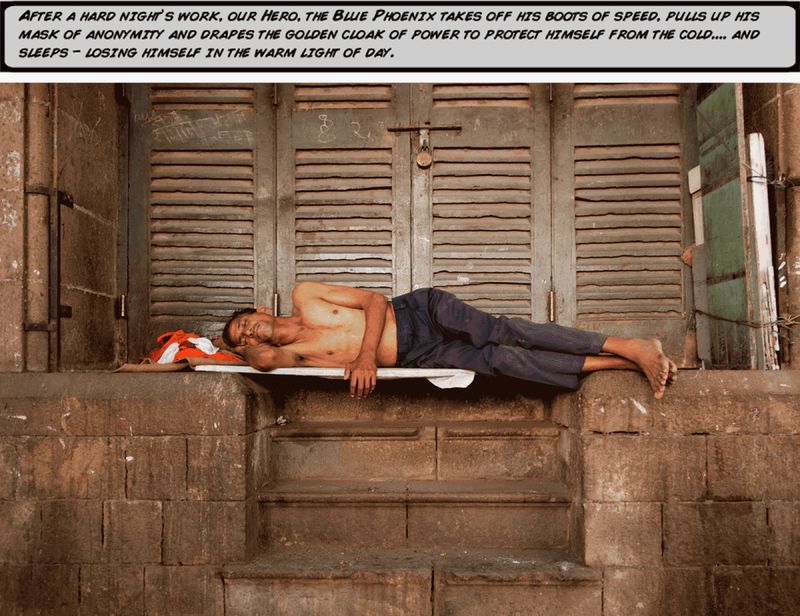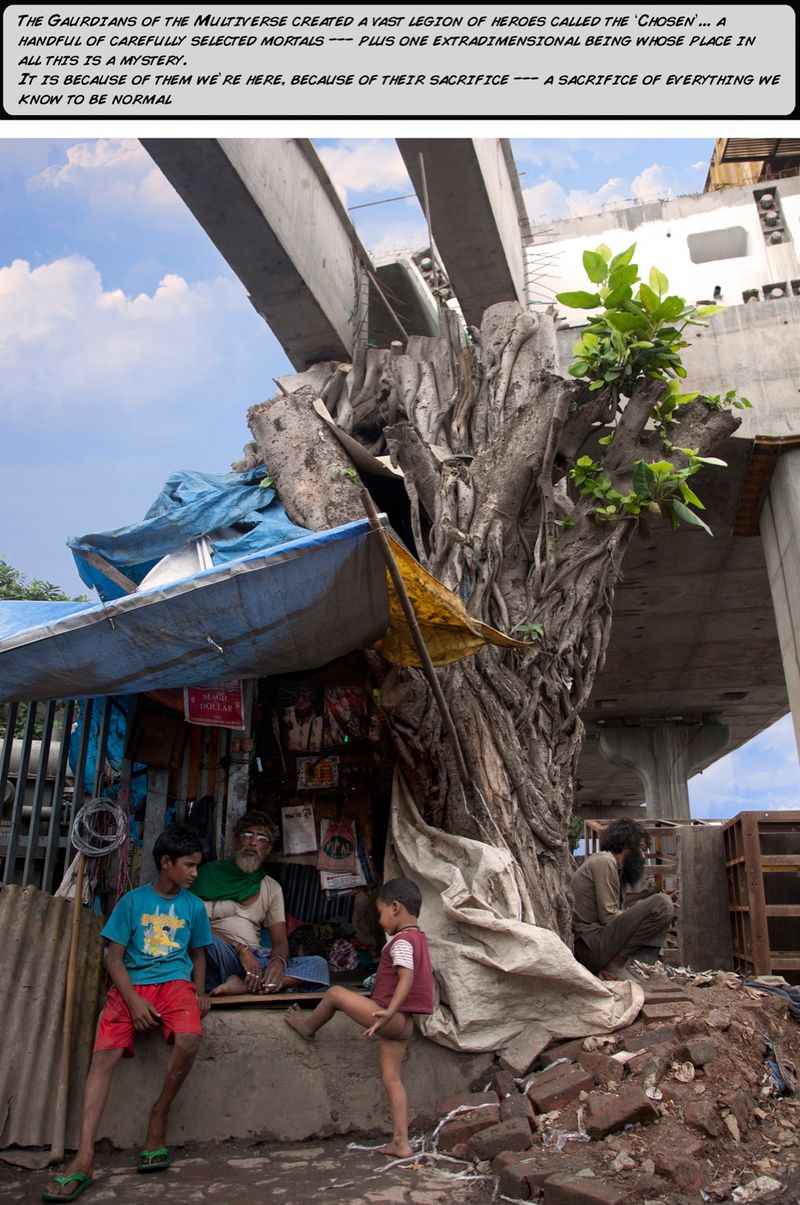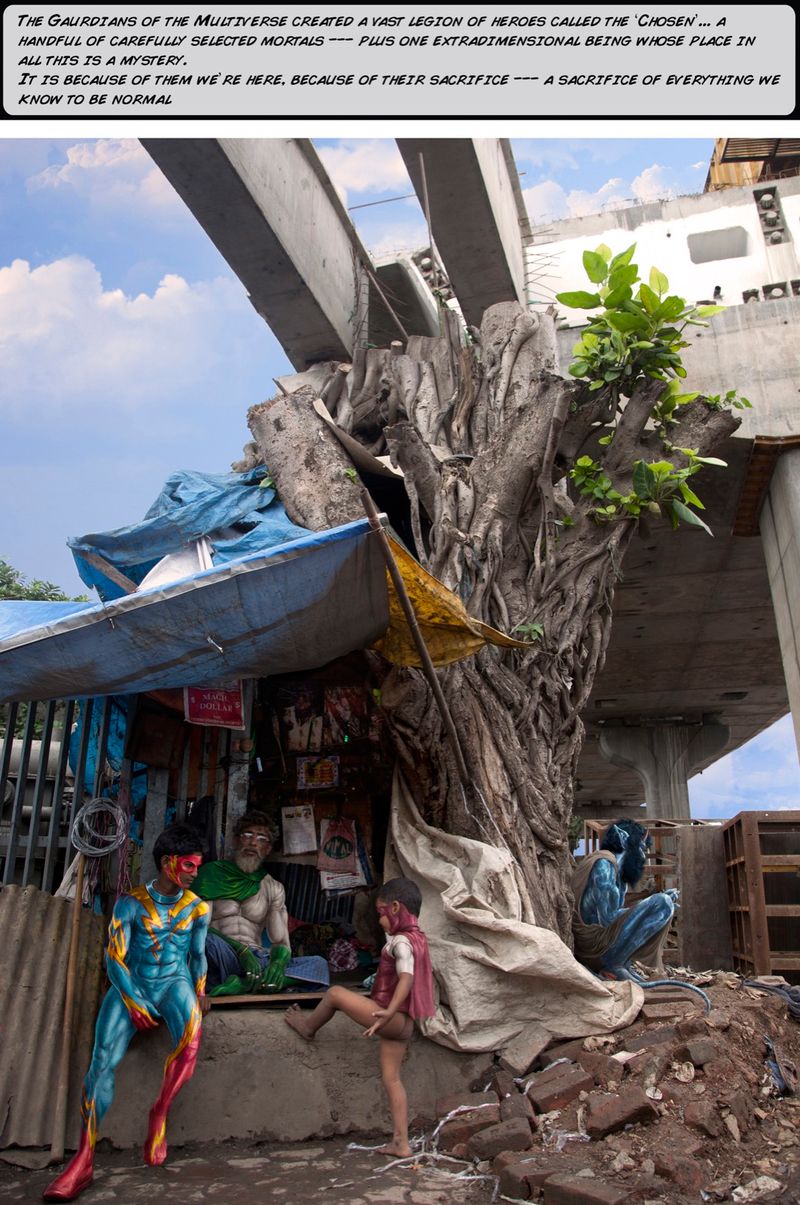
The Superhero Series
The Superhero Series is a suite of digitally painted photographs and made as archival lenticular prints.
Of Men and Supermen
India Art Festival, by TAO Art Gallery, Mumbai, 2012







Of Men and Supermen TAO Art Gallery India Art Festival 2012 Mumbai
Of Men and Supermen is about the nature of truth, the hidden and the apparent and the difference between the real and fictional. They are extracted from a larger body of archival site-specific work based in Mazgaon and Wadibunder that is a cross-section of a layered and multi-tiered space, which comprises an eclectic mix of temporary setups, chawls, shanties and tenements, amidst more permanent historic landmarks and its inhabitants. Documenting the life and living conditions of specific loosely strung together communities of people forced me to revisit these sites on a daily basis, and resulted in these spaces becoming stages set for the performance of the everyday.
The performance of the everyday is an act of resistance, to help bring those who are on the periphery into the center of the gaze. Who are these who have been photographed? What alternate realities are being projected on them? Are their dreams and aspirations an illusion?
These performances enable the idea of the fictional to percolate into the realm of the real, generating a new urban metascape and transforming people into the Superheroes of their own narratives.
This body of work engages with the duality of identity, overlapping the real and the fictional, forcing them to coexist and dissolving the barrier between the two.
Visual Disobedience
Interview by Kevin Lobo, for Visual Disobedience
Ali’s work was Visual Disobedience’s pick of the art on display by emerging artists at the India Art Festival this year. We speak to him about how pictures of the poor don’t need to be patronising, the magic of using lenticular and why superheroes are myths of the modern world.
Where did you click the original photographs?
I have been working on this series as an idea since March. I was part of an artist residency [at SPACE 118, in Mazgaon], documenting the vanishing culture of Mazgaon and Wadi Bunder. My documentation was split into three parts – discovering the Site, Stage and Structure of Mazgoan and Wadi Bunder. So Site was the absolute geographical location, the Stage was pictures of the performances of the everyday and Structure was the area’s architecture. The pictures that I have selected are from the Stage part of my documentation.
Where did the superhero concept arise from?
I love the idea of superheroes as a contemporary myth. The pictures are of the working class, beggars and street urchins. I think of them as heroes because of their struggle for survival. It is a way of looking at their lives as heroic, a lionisation of these people. There is a certain amount of nobility in what they do. But there is a duality to this. They don’t really want to be lionised though or recognised as anything special. Conceptually, the work is also about fiction and reality and blurring the lines between the two.
Lenticular has shown this blur between reality and fiction quite literally. How did you come across this medium?
I think lenticular has been part of all of our childhoods. We had those taazos and then these round things we would get in Lays packets. Now lenticular prints of gods and goddesses have become famous. I never thought about it as amaterial for a particular work. But doing this work in video did not seem good enough. I wanted the viewer to see both, the original photograph and the costume. Also a photograph is more tangible, it’s almost a painting. All of this is fascinating.
Lenticular takes the work further. The superhero is one aspect of the composite and the secret identity of the real person is also important. This duality of the myth of superheroes becomes apparent because of lenticular. They are going about in the world doing what they do just like a superhero would. The costume might be fictionalisation, but the work is still asking whether these guys are invisible heroes or not. The trick as an artist is not stating which is which.
Were you conscious of not coming across as just another photographer with a bleeding heart?
I think I was very aware of that becoming a possibility in this series and I have very consciously stayed away from images that would seem condescending, or patronising or even cute. What I’ve ended up with is photographs of people who were involved in their own work. They weren’t pretending to do something else. They were being who they are, no pretence. Using lenticular as a technology, I was able to show the original subject as he or she is, but add my perspective on it too.
How did you select the costumes for the superheroes?
I wanted my intervention to be very minimal. I didn’t want to abandon the style of the golden age of superhero comics of the’50s and ’60s. There is a certain sense of drama, and the language is a little over-the-top and flowery. It has a certain identity. That’s the connect I wanted. The costumes in that sense are flashy at times. What became important for me to look at the image for what it is. There is one guy who is pulling a hand cart. The photograph itself comes across as a Herculean figure pulling a huge load. The photographs gave me clues. This guy needed super strength – so muscle not armour. Colour schemes came out of what they were wearing originally. That simplicity seems fantastic.
What is the response to the show, and where do you go with this?
A lot of the times, people who are observing the work walk past it expecting it to be yet another poor man’s photograph, but stop midway realising there is something special happening. That moment of magic is fabulous. Lenticular became, for me, the right blend of magic and simplicity in this work. In a way, this show ties up with what I have been doing since my first solo show at Tao. I had painted the face of the harlequin on faces of lesser privileged people for the series called Everybody is a Jester. For the India Art Festival, I have completed just seven pieces because of space constraints. But I hope this will be a much larger body of work.
Ali Akbar Mehta in conversation with Namrata Bhawnani
Ali Akbar Mehta’s apartment in Madh Island doubles up as a studio for the artist and it’s not tough to see why he chose to make the island his base. The cosy sea-view apartment, with a balcony that overlooks a soothing green expanse, offers a sense of serenity in a chaotic city like Mumbai and is no doubt a stimulating space for an artist.
This enviable space’s resident, Mehta (29), recently showcased his lenticular series Of Men and Supermen at the India Art Festival. With five of seven works sold, Ali’s series stood out, making him an artist to watch out for. Costumes of superheroes were imposed on photographs of faces on the street. The photographs were extracted from a larger body of archival site-specific work based in Mazgaon and Wadibunder, which comprises an eclectic mix of chawls, shanties and tenements, amidst more permanent historic landmarks and its inhabitants. Mehta says, “These are characters we look at but don’t see them, they belong to the periphery of our vision. The fictional percolates into the realm of the real, generating a new urban metascape and transforming people into the Superheroes of their own narratives.”
The choice of the lenticular medium was crucial as it made the process transparent. Mehta explains, “Here people are able to see the original image and my interpretation of the work. The work is the engagement of reality and fiction.”
Mehta’s fascination with superheroes is the connecting link through his earlier works. In 2011, Tao Gallery hosted his first solo show titled The Ballad Of The War That Never Was And Other Bastardised Myths, a prolific mix of video, oil on canvas and digital art. Most of the 30 works found buyers and enthused a fresh young audience to experience the art.
The JJ school of art graduate explains why superheroes intrigue him, “The idea of the hero in the mythological context has fascinated me. The roots are from graphic novels, cartoons and comics. I’m deeply influenced by science-fiction, manga, anime, animation and so a lot of my visual vocabulary has been influenced by them. With the lenticular series, rather than me working with a very Indian popular heroic identity which may be Bollywoodish, I went with my understanding of what it means to be a superhero… Superman comics are a fable, not of strength, but of disintegration. They appeal to the preadolescent, (sic) mind not because they reiterate grandiose delusions, but because they reiterate a very deep cry for help.
Now, a staple of the superhero mythology is, there’s the superhero and there’s the alter ego. Batman is actually Bruce Wayne, Spider-Man is actually Peter Parker. When that character wakes up in the morning, he’s Peter Parker. He has to put on a costume to become Spider-Man. And it is in that characteristic Superman stands alone. Superman didn’t become Superman. Superman was born Superman. When Superman wakes up in the morning, he’s Superman. His alter ego is Clark Kent. His outfit with the big red “S” – that’s the blanket he was wrapped in as a baby when the Kents found him. Those are his clothes. What Kent wears – the glasses, the business suit – that’s the costume. That’s the costume Superman wears to blend in with us. Clark Kent is how Superman views us. And what are the characteristics of Clark Kent? He’s weak… He’s unsure of himself… He’s a coward.
Clark Kent is Superman’s critique on the whole human race.
“Superhero science has taught me this: Entire universes fit comfortably inside our skulls. Not just one or two but endless universes can be packed into that dark, wet, and bony hollow without breaking it open from the inside. The space in our heads will stretch to accommodate them all. The real doorway to the fifth dimension was always right here. Inside. That infinite interior space contains all the divine, the alien, and the unworldly we’ll ever need.”
Jesters, harlequins and zombies populate Mehta’s works in a surreal world of chaos, dreams and constant flux, with violence forming a strong contextual running theme in his solo show. He elaborates, “The idea of violence in all its forms became very important because within the context of mythology, the tragic is so sublime. With my oil on canvases, I was trying to create these heroic visions of ourselves in a very decontextualised format. I did not want any kind of cultural markers to distract the viewer from the idea of violence. That became important in talking about a universal identity. Hybrid cultures and mythologies emerge and the idea of new archetypes of the 21st century excites me.”
Digital art has always been a point of debate in the art world, which hasn’t been quick to embrace its onslaught. However, Mehta remains unperturbed, “The digital in all its possibilities is a fantastic medium of its age. Before oil on canvas, there were frescoes and tempura. If you forget that transition, this whole scene seems like a shortcut, which comes from not understanding the tools you’re working with. The process remains the same, just the tools change. Digital art has permeated our vocabulary in different ways but unfortunately it hasn’t permeated the art world yet. The more veteran collectors also loved the work but there is also a lifetime of not having interacted with it. The genre needs exposure and needs to be talked about.”
The League of Superheroes


The guardians of the Multiverse created a vast legion of Heroes called the chosen… A handful of carefully selected mortals – plus one extradimensional being whose place in all this is a mystery. It is because of them we’re here, because of their sacrifice – a sacrifice of everything we know to be normal.
Equilibrium
TAO Art Gallery, Mumbai
The League of Superheroes was exhibited at Equilibrium February 20 -March 08, 2013 Tao Art Gallery Window Gallery Space
Participating artists:
Akbar padamsee | Ali akbar mehta | Anwar | Arunanshu Chowdhury | Arzan Khambatta | Bbaiju Parthan | Brinda Chudasama Miller | C. Jagdish | Ganesh Haloi | Debasish Dutta | Devdatta Padekar | Dhruvi Acharya | Gieve Patel | Indrajeet Prasad | Jagdish Chander | Jaideep Mehrotra | Jayasri Burman | K. G. Subramaniyan | K. S. Radhakrishanan | Kalpana Shah | Karl Antao | Krishen Khanna | Madhvi Parekh | Manu Parekh | Nanda Das | Paresh Maity | Payal Khandwala | Ratnadeep Adivrekar | Ravi Mandlik | Rini Dhumal | Sakti Burman Samir Mondal | Sanjay Kumar | Satish Gujral | Seema Kohli | Senaka Senanayake | Shuvaprasanna | Sohan Qadri | Somenath Maity | Sudhir Patwardhan | Sunil Padwal | Suryaprakash | Venkatesh Pate | Vijay Shinde | Yeshwant Deshmukh
The works will be on display at the window gallery space of Tao Art Gallery, Worli, till 8 March 2013
Press for exhibtion